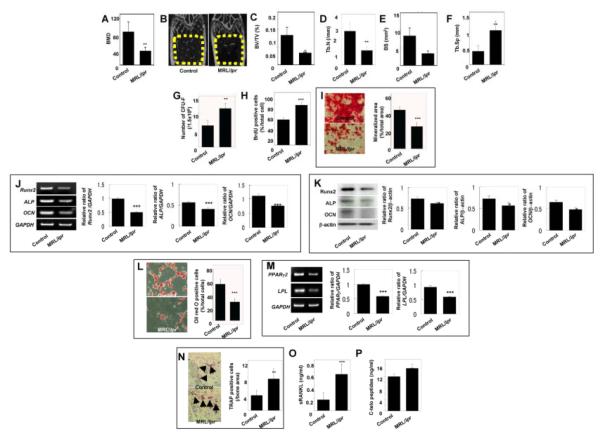Figure 1.
BMMSC deficiency in MRL/lpr mice (A-F) MicroQCT analysis of the trabecular bone structure of the distal femoral metaphysis at 20-week-old MRL/lpr mice. MRL/lpr mice (MRL/lpr) exhibited significantly decreased bone mineral density (BMD, A). Representative microQCT images of the trabecular bone structure in MRL/lpr mice (n=5) exhibited a significant decrease in bone formation (yellow circle areas, B), bone volume relative to tissue volume (BV/TV, C), trabecular number (Tb.N, D), and bone surface area (BS, E) along with significantly increased trabecular separation (Tb.Sp, F) when compared to the control C3H/HeJ group (Control, n=5; mean±SD; [[P<0.01). (G) The number of CFU-F (mean±SD) in MRL/lpr mice (n=5) increased significantly as compared to the control group (n=5, [[P<0.01). (H) BMMSCs derived from MRL/lpr mice (n=5) showed significantly elevated BrdU-uptake rate. (mean±SD; Control, n=5; [[[P<0.001). (I) Representative images of alizarin red staining of BMMSC cultures under the osteogenic conditions. BMMSCs derived from MRL/lpr mice (n=5) showed significantly decreased calcium accumulation (mean±SD; Control, n=5; [[[P<0.001). (J, K) Semi-quantitative RT-PCR (J) and Western blot (K) analysis showed that MRL/lpr-derived BMMSCs presented significant decrease in the expression of Runx2, ALP, and OCN. Glycerinaldehyd-3-phosphat-dehydrogenase (GAPDH) and β-actin were used as loading controls in RT-PCR and Western blot, respectively. Five repeated tests per group showed similar results ([[[P<0.001; [P<0.05). (L) Representative images of Oil red O staining of BMMSC cultures under the adipogenic conditions. BMMSCs derived from MRL/lpr mice (n=5) showed a significant decreased number of adipocytes (mean±SD; Control, n=5; [[[P<0.001). (M) Semi-quantitative RT-PCR analysis indicated that MRL/lpr-derived BMMSCs had significant decrease in gene expression of PPARγ2 and LPL compared to loading control GAPDH. Five repeated tests per group showed similar results ([[[P<0.001). (N) TRAP staining indicated the increased number of TRAP positive cells (mean±SD) in epiphysis of the distal femurs of MRL/lpr mice (n=5) as compared to the control (Control, n=5; [[P<0.01). (O, P) ELISA revealed that MRL/lpr mice (n=5) have increased levels (mean±SD) of soluble RANKL (sRANKL) (O, [[[P<0.001) and C-terminal telopeptides of type I collagen (C-telopeptides, P, [[P<0.01) in serum as compared to the controls (n=5).

